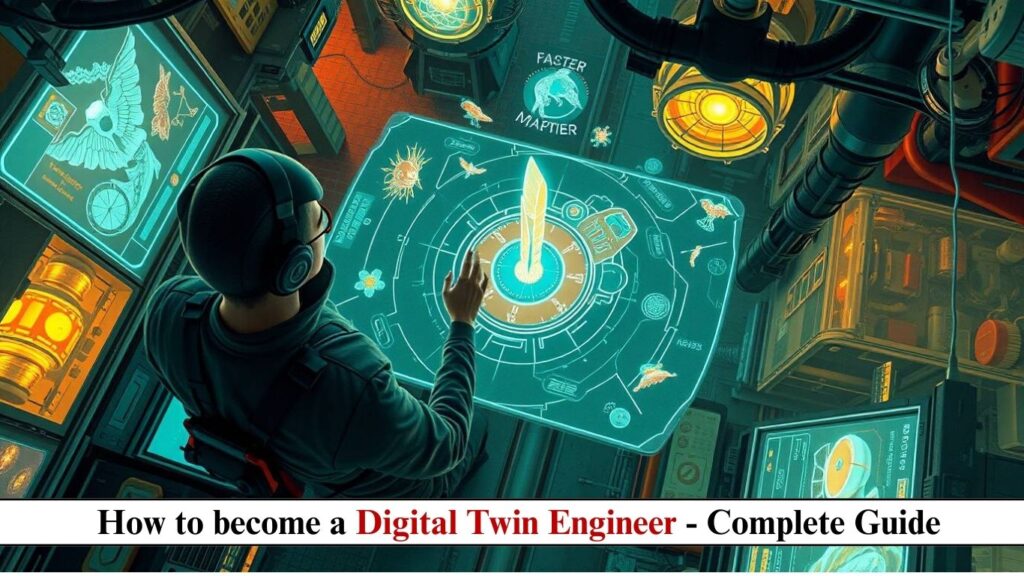
Introduction to Digital Twin Technology
Digital twins are revolutionizing industries by creating virtual replicas of physical systems. A Digital Twin Engineer designs, develops, and maintains these dynamic digital models that simulate real-world objects, processes, or systems in real-time.
This comprehensive guide covers:
- The evolution of digital twin technology
- Salary expectations across industries
- Roles and responsibilities of digital twin engineers
- Required qualifications and skills
- Step-by-step guide to launching your career
- Future applications and industry trends
History of Digital Twin Technology
Key Milestones in Digital Twin Development:
- 1960s: NASA pioneers early concepts with spacecraft simulations
- 2002: Dr. Michael Grieves formally introduces the term “digital twin” at the University of Michigan
- 2010s: IoT and cloud computing enable widespread adoption
- 2017: Gartner names digital twins a Top 10 Strategic Technology Trend
- 2020s: Integration with AI/ML for predictive analytics
- 2023: Market value reaches $73.5 billion (Grand View Research)
Today, digital twins are used across manufacturing, healthcare, smart cities, and aerospace.
Digital Twin Engineer Salary Outlook
Average Annual Salaries by Experience Level:
| Experience Level | Salary Range (USD) |
|---|---|
| Entry-Level (0-2 yrs) | $75,000 – $110,000 |
| Mid-Career (3-5 yrs) | $110,000 – $150,000 |
| Senior-Level (5+ yrs) | $150,000 – $220,000+ |
Industry-Specific Salary Benchmarks:
- Aerospace & Defense: $120,000 – $190,000
- Automotive Manufacturing: $105,000 – $170,000
- Healthcare & MedTech: $115,000 – $180,000
- Energy & Utilities: $100,000 – $160,000
Freelance consultants can earn $80-$250/hour for specialized projects.
Roles and Responsibilities
Digital twin engineers perform diverse functions across the technology lifecycle:
Core Responsibilities:
- System Modeling & Simulation
- Develop 3D virtual models using CAD software (SolidWorks, AutoCAD)
- Create physics-based simulations (ANSYS, MATLAB)
- IoT Integration
- Connect sensors and real-time data streams
- Implement edge computing solutions
- Data Analytics & AI
- Develop predictive maintenance algorithms
- Train ML models for anomaly detection
- Platform Development
- Build digital twin platforms using Unity, Unreal Engine, or specialized tools
- Ensure interoperability with existing systems
- Validation & Testing
- Conduct virtual stress tests
- Compare digital twin outputs with physical counterparts
Specialized Roles:
- Manufacturing Twin Specialist
- Smart City Twin Developer
- Healthcare Digital Twin Architect
Qualifications and Skills
Educational Pathways:
- Bachelor’s/Master’s in:
- Mechanical/Electrical Engineering
- Computer Science (AI/ML focus)
- Industrial & Systems Engineering
- Data Science
Technical Skills Matrix:
| Skill Category | Essential Tools/Technologies |
|---|---|
| 3D Modeling | CAD (SolidWorks, CATIA), BIM (Revit) |
| Simulation | ANSYS, Simulink, AnyLogic |
| Programming | Python, C++, Java, JavaScript |
| IoT/Cloud | AWS IoT, Azure Digital Twins, MQTT |
| Data Science | Pandas, TensorFlow, PyTorch |
| Visualization | Unity, Unreal Engine, Tableau |
Certifications to Consider:
- Digital Twin Professional (DTP) – Digital Twin Consortium
- AWS Certified IoT Specialty
- Siemens Digital Twin Certification
- ANSYS Simulation Certification
How to Become a Digital Twin Engineer
Step 1: Build Foundational Knowledge
- Take online courses:
- Coursera: “Digital Twins: From Concept to Practice”
- edX: “IoT and Digital Twins”
- Read industry reports from Gartner and McKinsey
Step 2: Develop Technical Skills
- Beginner Projects:
- Create a digital twin of a simple mechanical system
- Build a basic IoT sensor network
- Intermediate Projects:
- Develop a predictive maintenance model
- Simulate a smart building energy system
Step 3: Gain Practical Experience
- Internships at manufacturing/tech firms
- Contribute to open-source digital twin projects
- Participate in hackathons (e.g., NASA Space Apps Challenge)
Step 4: Build Your Professional Network
- Join the Digital Twin Consortium
- Attend Industry 4.0 conferences
- Connect with professionals on LinkedIn groups
Step 5: Specialize and Advance
- Choose an industry focus (e.g., healthcare, energy)
- Pursue advanced certifications
- Consider a master’s in relevant engineering fields
Future of Digital Twin Technology
Emerging Applications:
- Climate Modeling: Simulating ecosystems for sustainability
- Human Digital Twins: Personalized medicine applications
- Metaverse Integration: Bridging physical and virtual worlds
- Autonomous Systems: Real-time control of robotics
Industry Growth Projections:
- Market size: Expected to reach $125.7 billion by 2030 (CAGR of 39.1%)
- Hot sectors: Renewable energy, pharmaceutical manufacturing, defense
Technological Advancements:
- AI-powered twins: Self-learning simulation models
- Quantum computing: Enabling ultra-complex simulations
- 5G/6G networks: Supporting massive IoT deployments
Conclusion: Is Digital Twin Engineering Right for You?
This field offers exceptional growth potential for professionals who enjoy:
- Interdisciplinary problem-solving
- Cutting-edge technology development
- High-impact industry applications
Your Career Launch Checklist:
- Master 3D modeling and simulation tools
- Develop strong programming and data skills
- Build a portfolio of digital twin projects
- Network with industry professionals
The digital twin revolution is just beginning – will you help shape its future?













Post Comment